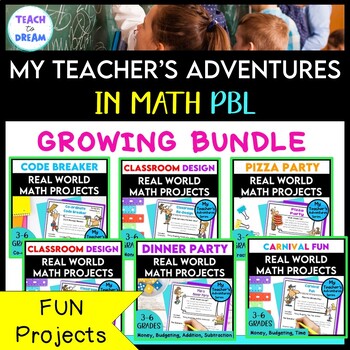Real World Math Projects Bundle | Summer School Curriculum - Grade 4th 5th 6th
- Zip
Products in this Bundle (12)
showing 1-5 of 12 products
Description
Bring Real World experiences into your math lessons with these exciting Math PBL activities. The growing bundle math projects has been developed to be completed by teachers that have limited time. Each Math project covers a range of math skills and provides students with the opportunity to transfer their knowledge. It has been designed for students in grades 3 to 6.
Are you looking for the hook to get your students excited in math? Students love thinking about what their teacher's lives are like outside of school. This is how the "My Teacher's Adventures in series" was started. Let your students work on mathematical projects of fun adventures/ stories about possible scenarios that you as a teacher may have!
The project is designed to run between 2-3 lessons depending on how much time you wish to allocate to the tasks.
The projects are easy to follow and can either be teacher run or student driven.
By purchasing this BUNDLE YOU ARE SAVING 30% OFF the individual price of each resource. The price will increase each time a new resource is added, buy now to receive all future additional projects for free!
Each Project in this resource includes:
✔ Student Project page with task and requirements.
✔ Teacher assessment
✔ Self/ peer assessment
✔ Working out/ design pages
** Suitable for both USA and UK/ AUS classroom.
✎ Titles of resources currently included in this growing bundle:
- Design a Guest House (3D shapes, nets, measurement)
- Dinner Party (money, budgeting)
- New Pet (tallies, graphs)
- Summer Vacation (money, budgeting, time)
- Pixel Art (Fractions, decimals)
- Pizza Party (Fractions, number)
- Class Re-design (Money, decimals, budgeting)
- School Supplies (Money, budgeting)
- Code Breaker (Co-ordinates and Co-ordinate Planes)
- Carnival Fun (Money, budgeting, time and time duration)
- Zoo Day (Time and time duration)
- Flower Power (Money and budgeting)
This project can be used in many ways, including:
1. At the end of a unit of work to test knowledge.
2. Fun Friday Math lessons.
3. Group work
4. For fast finishers
5. Fun projects for students to complete for homework.
You may also be interested in the following resources:
Mini Math Investigations: Money
Mini Math Investigations: Fractions





